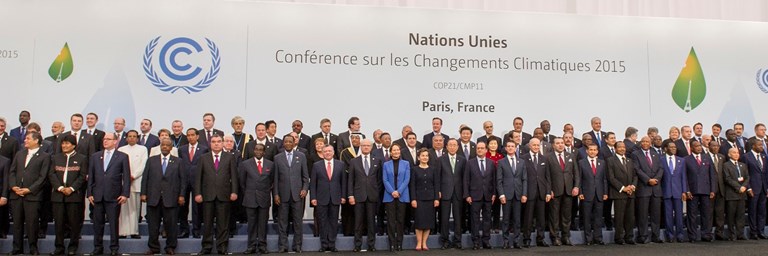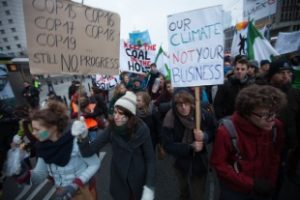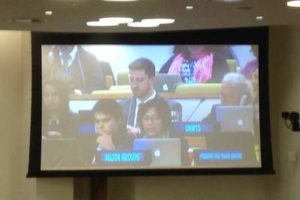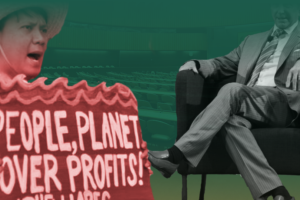IBON International Updates #12
Climate Justice
[[{“type”:”media”,”view_mode”:”media_large”,”fid”:”1230″,”attributes”:{“alt”:””,”class”:”media-image”,”height”:”160″,”typeof”:”foaf:Image”,”width”:”480″}}]]
(Paris, France, December 8, 2015) – The 21st meeting of the Conference of Parties (COP) of the United Nations Framework Convention on Climate Change (UNFCCC) only has a few days left to smooth out an international agreement for measures that will keep the world and its inhabitants safe.
The COP 21 opened last week with huge pronouncements from 140 world leaders to take stronger action to halt further global warming and to lead the world towards more sustainable pathways.
From Obama to Trudeau to Cameron, the world’s biggest climate polluters supported calls by the most vulnerable countries for a stronger target to limit global temperature rise to 1.5C. The current temperature goal on the negotiating table is an increase of 2 degrees C, and many vulnerable countries say that this level of ambition is too low and would spell doom especially for those communities in low-lying areas.
These seemingly bold and grand pronouncements from the industrial powers elicited mixed reactions from developing countries, other intergovernmental agencies and observers, including civil society. There were those that welcomed the 1.5C target goal and considered it a breakthrough that the world’s biggest and historical polluters have even upped the ambition to stave off runaway climate change. Some are hopeful that after years of long debates, countries appear to be in unison in their resolve. Others however, contend that these seemingly brave declarations need to be unpacked and nuanced.
A 1.5C global temperature limit goal would mean that the industrial powers like the United Kingdom would have to undertake measures to reduce their emissions by more than 80% by 2030. This could spell a total economic overhaul in their country’s production systems, a move that would entail shutting down their industries in a couple of years. This is not only expensive, in terms of ensuring that their productive activities do not emit any more pollution, but costly as well, in terms of the possible economic (and political) dislocation this will result in.
Presently among the biggest carbon emitters, India and China have accepted the 1.5C goal in principle, but add that there needs to be more clarity on just how this may be implemented as this would severely constrict the capacity of developing countries to chart their own development path.
Developing countries contend that this ambitious target is acceptable provided that the Paris agreement recognizes a ‘fair sharing’ of the world’s remaining carbon budget, i.e. just how much carbon dioxide emissions can accumulate before global temperature reaches the tipping point. The argument here is that developed countries have already used up more than their fair share of the carbon budget in the course of growing their economies, and that whatever is left must be apportioned to allow developing countries to achieve a certain level of economic growth. This argument is in line with the UNFCCC principle of ‘common but differentiated responsibility and respective capabilities’ (CBDR-RC). It means that countries that have contributed the most to the climate crisis must do more to cut down their pollution and help countries that are impacted.
The debate over the 1.5C goal gets even more complicated when the issue of financing is taken on board. A US proposal last week that financing climate action should be an equal responsibility of both rich and poor countries has also elicited negative reactions and allegations of undermining the (UNFCCC) process and rewriting the principles with which it was founded. In framing the debates around ‘vulnerability’, developed countries elude historical responsibility for cutting emissions, as well as paying for climate action. Simply put, developing countries could not count on new and additional financing. The US-led Climate Vulnerable Forum, of which the Philippines is chair, has obfuscated the issue by pitting ‘vulnerability’ (where each country is now facing vulnerabilities) against the historical responsibility of developed countries.
This divergence extends to the issue of loss and damage, with rich countries saying they could accept this provided they are off the hook on footing the bill for developing countries hit by extreme weather events and other long-term environmental impacts. Developing countries are locked in heated negotiations on loss and damage, which they contend is over and above the costs of adaptation.
And as in the previous week, a lot of negotiations are being conducted in closed-doors and without the watchful eyes of observers like civil society groups. There are also accounts of arm-twisting tactics by rich countries, with some of them even threatening to withdraw foreign aid (Official Development Assistance) if developing countries will not accept the conditions set by the rich countries.
The French government intends to conclude the negotiations by Friday, December 11th. At best, this timeline is a huge challenge considering that there remain stark differences in opinions. At worst, it could mean more strong-arm tactics, including heightening the divide (and rule) between responsibility and vulnerability. #



